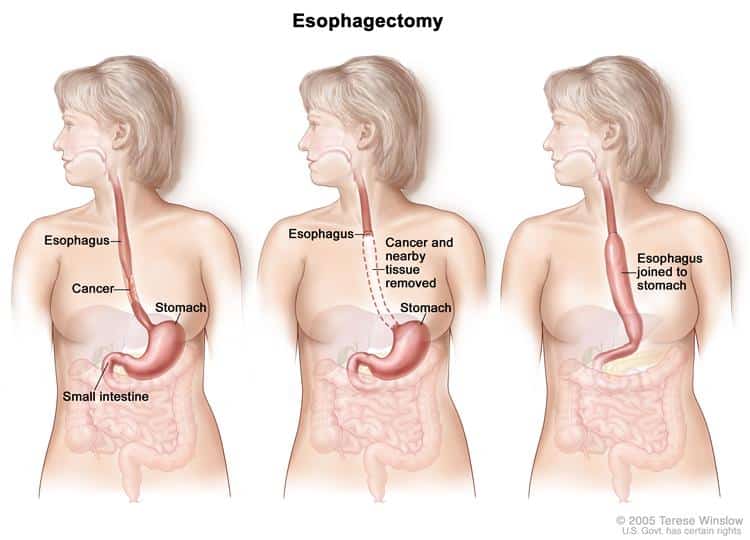Esophagectomy – Overview
Esophagectomy is a surgical procedure that is carried out to remove all or part of the esophagus. The esophagus is the food pipe that connects the buccal cavity (mouth) to the stomach.
The esophagus is composed of several layers of tissue, including mucous membrane, muscle, and connective tissue. Once a part of the esophagus is removed, the stomach is pulled up and joined to the remaining esophagus.
Indication for Esophagectomy
Esophagectomy is usually done for patients with esophageal cancer, i.e. cancer of the esophagus. Patients with esophageal cancer often show symptoms such as difficulty in swallowing, weight loss, hoarse voice and dry cough.
Esophagectomy is most effective when the cancer is in its early and has not spread to other parts of the body. For advanced-stage cancers, multiple forms of treatment as chemotherapy and radiation therapy are needed.
Esophagectomy is also performed on patients with esophageal atresia, a birth defect in which the esophagus does not have an opening into the stomach.
Surgical Techniques
Types of Esophagectomy
Esophagectomy can be classified into two main types:
- Transhiatal Esophagectomy (THE)
- Transthoracic Esophagectomy (TTE)
Transhiatal Esophagectomy (THE)
A transmittal esophagectomy (THE) is performed on the neck and abdomen simultaneously. During a transhiatal esophagectomy, an incision is made from the bottom of the breastbone to the belly button. Another small incision is made on the left side of the neck.
The surgeon removes the esophagus, moves the stomach up to the area in the neck where the esophagus was removed and connects the remaining portion to the stomach in the neck.
Transthoracic Esophagectomy (TTE)
A transthoracic esophagectomy (TTE) involves opening the thorax (chest). The section of the esophagus with cancer and the upper part of the stomach is removed.
The remaining portions of the esophagus and stomach are then connected to rebuild a digestive tract. In some cases, part of the colon is used to replace the removed section of the esophagus. Lymph nodes in the chest or neck may also be removed if they’re cancerous.

Esophagectomy
Process of Esophagectomy
Esophagectomy is a very complex operation and as such, it is performed by specialists in upper gastrointestinal surgery. The duration of the surgery is about 4 to 8 hours. Administration of anesthesia to the patient is very complex due to problems with managing the patient’s airway and lung function during the operation. After the surgery, there is usually a hospital stay of about two weeks.
Esophagectomy Complications
The complications of esophagectomy surgery include the possibility of lung collapse, loss of diaphragmatic function, and possible injury to the spleen.
As with any surgery, the general possible complications include:
- Bleeding
- blood clots in the legs that may travel to the lungs
- infection
- bad reaction to anesthesia
- leakage problems
- breathing problems
Esophagectomy Survival Rate
Average mortality rates, i.e. deaths either in a hospital or within 30 days of surgery for esophagectomy are around 10% in US hospitals.
According to a study in the World Journal of Surgical Oncology, the survival rates after esophagectomy was about 30% by 5 years, and 20% by 10 years.
Esophagectomy Recovery
After surgery, patients may have trouble with a regular diet and may have to consume softer foods, avoid liquids at meals, and stay upright for 1–3 hours after eating.
Difficulty in swallowing is common and patients are encouraged to chew foods very well or grind their food.
Patients may complain of substernal pain that resolves by sipping fluids or regurgitating food.
Your diet may be the hardest part to adjust to after your surgery, and you may lose weight. However, most people adjust to the changes in their body and new diet about four to six months after the surgery.
Read More: Rib Removal Surgery


